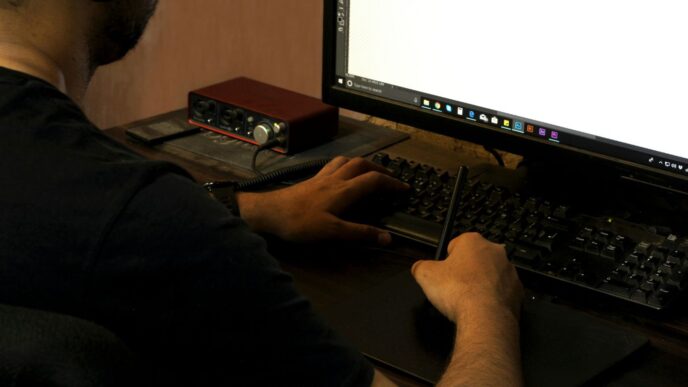So, HP snagged Humane AI, the folks behind that AI Pin thing. Remember that? It was supposed to be the next big step in how we talk to computers, ditching screens for something more, I don’t know, futuristic? It didn’t exactly pan out, though. Now HP’s stepping in. What does this mean for where we’re headed with AI and our gadgets? Let’s break it down.
Key Takeaways
- The Humane AI Pin’s big idea was to move beyond smartphones, but it stumbled hard on basic tech and user experience. HP’s acquisition means they’re getting the pieces, but the puzzle wasn’t solved yet.
- Hardware issues, like a slow processor and a projector that barely worked, were major problems for the AI Pin. Plus, figuring out how to use it was a real headache for most people.
- HP could be looking to make a mark in wearable AI. They’re buying into the idea, even if Humane’s first attempt didn’t fly.
- The collaboration between Jony Ive and OpenAI is aiming for a truly new AI device, potentially the ‘iPhone of AI,’ learning from Humane’s public missteps.
- HP’s move seems to be about grabbing Humane’s tech and talent to build its own future in AI hardware, maybe trying to avoid the mistakes made by the AI Pin.
HP’s Strategic Acquisition Of Humane AI
The Humane AI Pin’s Ambitious Vision
Humane, the company behind the much-talked-about AI Pin, had a pretty big idea. They wanted to move beyond the smartphone, creating a wearable device that could handle tasks using just voice and a projector. It was a bold swing, aiming to be the "iPhone of AI," as some put it. The goal was to simplify our digital lives, making AI a more natural, integrated part of our day. Think of it as a personal assistant you wear, always ready to help without needing to pull out a phone. This vision, while ambitious, ultimately ran into some serious real-world hurdles.
Lessons Learned From The AI Pin’s Failure
So, what went wrong? Well, the AI Pin didn’t exactly set the world on fire. Reviews pointed out a bunch of issues. For starters, the device wasn’t always reliable. Sometimes it just didn’t respond, or it was slow to do what you asked. The whole screenless, voice-and-projection thing was also a bit of a learning curve, and not always a smooth one. It felt like it was asking users to change how they interact with tech quite a bit, which is a tough sell. The market wasn’t quite ready for such a radical shift in user experience. It turns out, making something completely new is harder than it looks, especially when people are used to how things already work.
HP’s Move To Acquire Humane AI
This is where HP comes in. They saw something in Humane, despite the AI Pin’s struggles. HP decided to buy the company for a reported $116 million. This wasn’t just about picking up a struggling product; it was about acquiring the technology and, importantly, the people behind it. HP is looking to boost its own AI efforts, especially with the growing interest in AI-powered PCs. Acquiring Humane’s intellectual property, which includes over 300 patents and patent applications, gives HP a significant leg up in developing new AI hardware. It’s a strategic move to get a piece of the future of personal computing and wearable tech.
Analyzing The Humane AI Pin’s Shortcomings

So, let’s talk about the Humane AI Pin. It was supposed to be this big leap forward, right? A device to free us from our phones. But, uh, it didn’t quite work out that way. The biggest issue was that the tech just wasn’t ready for the grand vision. It felt like they were trying to build a spaceship with parts from a bicycle.
Hardware Limitations And Performance Issues
First off, the hardware. For a device meant to be this cutting-edge AI companion, it was running on some pretty old tech. We’re talking about a processor that felt sluggish, even for basic tasks. This meant:
- Laggy responses: Asking it a simple question could take ages, if it answered at all.
- Overheating: Users reported the device getting uncomfortably warm, sometimes too hot to touch.
- Battery drain: The battery life was pretty dismal, often not lasting a full day, which is a big problem for a wearable.
The much-hyped "Laser Ink" display, which projected information onto your hand, was another letdown. It was practically invisible in any kind of bright light, making it useless outdoors. It was a neat idea, but the execution just wasn’t there.
User Experience And Interface Challenges
Then there’s the user experience. The whole point was to be screenless and intuitive, but it ended up being confusing and, frankly, awkward to use. Imagine trying to interact with something that doesn’t show you what it’s doing.
- Voice command struggles: It often misunderstood commands or just didn’t respond, leading to a lot of repeated shouting.
- Gesture confusion: The hand gestures required to control it were not intuitive and often misinterpreted.
- Social awkwardness: Having to stop and talk to a device on your chest in public felt pretty strange for most people.
It created more friction than it solved, forcing users to learn a whole new, often frustrating, way of doing things. It was a far cry from the simple, helpful assistant they promised.
AI Capabilities: A Promise Unfulfilled
And the AI itself? Well, that was the core promise, and it really fell short. The AI was supposed to be smart, contextual, and helpful. Instead, it was often:
- Inaccurate: It would confidently give wrong answers, sometimes wildly so. One reviewer noted it mistook a famous cave for a different landmark entirely.
- Unreliable: Basic functions like sending a text message or making a call frequently failed. It felt like a coin toss whether it would work.
- Slow and disconnected: Because it relied so heavily on the cloud, there was a noticeable delay in responses, making conversations feel stilted.
This unreliability meant you couldn’t trust it with important tasks, which defeats the purpose of having an AI assistant. It was a classic case of ambition outpacing actual capability, a lesson HP will surely consider as they move forward with their own AI hardware innovation.
The Future Of Human-AI Interaction Post-Acquisition
So, HP snagging Humane AI? It’s a pretty big deal, and it really makes you think about where all this AI stuff is headed. Humane tried something totally different with the AI Pin, right? They wanted a device that was all about talking to it, no screens, just pure AI interaction. It was ambitious, maybe too ambitious, and we all saw how that played out. But the idea behind it, that a device could be a true AI companion, that’s still out there.
HP’s Potential In The Wearable AI Market
Now, HP is looking at this and thinking, ‘Okay, how do we make this work?’ They’ve got the chance to take the lessons learned from Humane’s stumbles and build something better. HP could be the company that finally nails the wearable AI experience. Think about it: they have a huge reach in consumer electronics. If they can combine Jony Ive’s design smarts with the AI brains from OpenAI (who are powering a lot of this new AI wave), they might actually create something people want to wear and use every day. It’s not just about making another gadget; it’s about rethinking how we interact with technology on the go. We could see devices that are less about apps and more about just getting things done through natural conversation.
The Role Of OpenAI And Jony Ive’s Vision
This is where it gets really interesting. OpenAI is the powerhouse behind a lot of the AI that feels genuinely smart right now. They’ve got the models that can actually understand and respond in useful ways. Then you have Jony Ive, the guy who basically defined what desirable tech looks like for a generation at Apple. If HP can get these two forces working together, with Ive shaping the physical form and OpenAI providing the intelligence, they could create something truly special. It’s about making AI feel less like a tool you have to command and more like a helpful presence. Imagine a device that’s as intuitive to use as it is beautiful to look at, and it actually works reliably.
Defining The Next Generation Of AI Companions
What does the next generation of AI companions look like? It’s probably not going to be a phone replacement, at least not at first. It’s more likely to be a device that complements our existing tech. We’re talking about:
- Reliability First: No more laggy responses or AI that just doesn’t get it. The focus will be on making sure it works, every time.
- Clear Purpose: Instead of trying to do everything, these devices will likely have a specific job, like being a super-smart assistant for quick tasks or information.
- Natural Interaction: Voice and maybe even gesture control will be key, making it easy to use without pulling out a phone.
- Context Awareness: The AI will need to understand what you’re doing and where you are to be truly helpful, like knowing to add an address from a text message directly to your contacts.
HP’s acquisition of Humane AI isn’t just about buying a company; it’s about buying into a vision. It’s a chance to learn from mistakes and build the kind of AI interaction that feels less like science fiction and more like everyday life.
Comparing Humane AI’s Approach With Industry Leaders
When you look at what Humane was trying to do with the AI Pin, it really stands out how different their path was compared to the big players in the tech world. It was like they were trying to build a rocket ship when everyone else was perfecting their cars.
Revolutionary Ambition Versus Evolutionary Strategy
Humane went for a complete shake-up. They wanted to ditch screens altogether, relying on voice commands and little projections. It was a bold idea, aiming to create a whole new way to interact with AI. But, as we saw, it was pretty clunky. The AI was slow, often got things wrong, and honestly, it felt awkward to use in public. It demanded a lot from users, asking them to learn a new system that just didn’t feel natural.
On the flip side, companies like Apple are taking a more gradual approach. Think about the Apple Watch. It started as a simple device and has gotten smarter over time. Apple focuses on making existing interactions better and adding new features that feel like a natural step forward, not a giant leap into the unknown. They’ve got these things like the Smart Stack and the Action Button that just make sense. It’s about making things easier without making you feel like you’re learning a new language. This evolutionary path, building on what people already know, seems to be working much better for widespread adoption. It’s less about forcing a change and more about improving the current experience.
Ecosystem Synergy Versus Standalone Devices
Humane’s AI Pin was meant to be a standalone gadget. You bought it, you used it, and it was supposed to do its thing. This is a tough sell when most of our tech already talks to each other. Apple, for instance, has built a whole world where its devices work together. Your iPhone, your Watch, your Mac – they all connect. This makes adding new AI features to something like the Apple Watch feel more natural because it’s already part of a bigger system. It’s not just about the device itself, but how it fits into your digital life. This kind of integration is something startups struggle to replicate.
The Pragmatic Path To AI Integration
Humane’s AI was heavily reliant on the cloud. This meant it was often slow and unreliable. It felt like you were talking to a distant server, not a personal assistant. Apple, however, is pushing for more on-device processing. This means the AI can work faster, more privately, and more reliably, understanding your personal context without sending everything off to the cloud. For example, Apple Intelligence can look at what’s on your screen and understand a command like "Add this address to their contact card." It’s about AI that’s actually useful for everyday tasks, not just a fancy, unreliable gimmick. The industry seems to be leaning towards practical, dependable AI that solves real problems, rather than just chasing a futuristic vision that doesn’t quite work yet. This pragmatic approach is key for building trust and getting people to actually rely on these new AI tools.
The Strategic Rationale Behind HP’s Humane AI Investment
So, HP buying up Humane AI? It’s more than just picking up the pieces of a failed gadget. Think of it as HP grabbing a bunch of really interesting ideas and some smart people who were trying to do something totally different. Humane’s big idea was to ditch the screen and interact with AI using just your voice and maybe some projections. It was ambitious, for sure, but it didn’t quite work out in the real world. People found it confusing and, honestly, a bit awkward to use.
Acquiring Intellectual Property and Talent
What HP is really after here isn’t just the Humane AI Pin itself, which had its share of problems. It’s the underlying technology and, more importantly, the minds behind it. Humane had some unique approaches to how AI could work without a traditional screen. HP is likely looking to take these concepts and the engineers who developed them and integrate them into their own product roadmap. It’s like buying a box of advanced Lego bricks and the builders who know how to put them together in new ways.
- Core AI Interaction Models: Humane explored voice-first and projection-based interfaces. HP could adapt these for future devices.
- Wearable Technology Concepts: Even though the Pin failed, it represented a distinct take on wearable AI. HP gets to study and build upon this.
- Skilled Engineering Team: The people who worked on the AI Pin have experience in a cutting-edge, albeit challenging, field. Talent is always a big part of these deals.
Positioning For Future AI Hardware Innovation
HP has a long history with hardware, from printers to PCs. They see that AI isn’t just going to live on our phones and computers; it’s going to be in everything. By acquiring Humane, HP is getting a head start in figuring out what that future hardware looks like. They’re not just buying a product; they’re buying a piece of the puzzle for what comes next in personal technology. It’s a way to experiment without having to build everything from scratch.
The "iPhone Of AI" Ambition
Look, everyone wants to create the next big thing, right? The "iPhone of AI" is the dream – a device that completely changes how we interact with technology. Humane aimed for that, and while they missed the mark, the ambition is still there. HP might be thinking that with their resources and Humane’s foundational ideas, they can get closer to that goal. It’s a long shot, maybe, but the potential payoff is huge. They’re betting that the core vision, if executed differently, could still be a game-changer.
The Race for the Future is Still On
So, the Humane AI Pin didn’t quite make it. It was a bold idea, for sure, trying to ditch the phone and go all-in on AI. But it turns out, making something that actually works well, is easy to use, and people actually want is pretty tough. We saw a lot of promise, but the execution just wasn’t there. Now, with HP stepping in, it’s a whole new chapter. It’s a reminder that this whole AI thing is still pretty new, and we’re all learning as we go. What comes next is anyone’s guess, but one thing’s for sure: the journey to figure out how we’ll interact with AI is far from over. It’s going to be interesting to see what happens next.












